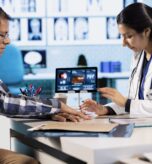Secure Your Choice: Compare Virtual vs Traditional Reception ROI
Virtual Front Desk vs Traditional Reception: ROI Analysis Managing a front desk has always been essential for patient satisfaction and clinic efficiency. However, with the rise of digital healthcare tools, the Virtual Front Desk vs Traditional Reception ROI question is now more relevant than ever. Clinics are actively comparing traditional reception setups to virtual solutions to determine which one brings better value. While a traditional front desk involves in-person staff and physical infrastructure, a virtual front desk uses remote professionals and digital systems. The return on investment (ROI) of each option depends on several factors including cost, efficiency, and patient experience. This article will help you understand both models in detail. We’ll walk through costs, hidden benefits, productivity, and more so you can make the right choice for your practice. You’ll also learn how tools like a virtual medical assistant or virtual medical office assistant contribute to overall ROI. What Is a Virtual Front Desk? A virtual front desk is a remote, tech-enabled service that handles front desk responsibilities such as scheduling, phone calls, patient check-ins, insurance verification, and more. Instead of hiring full-time staff onsite, clinics can outsource these tasks to trained professionals who work remotely. Virtual services usually operate through secure software platforms, allowing seamless interaction with patients and staff. These systems often come bundled with virtual medical assistant services, providing support without needing to invest in office space or extra equipment. Additionally, a virtual medical office assistant can manage day-to-day admin work, process EHR updates, and assist in streamlining operations. By using such roles, clinics gain flexibility and improve workflow without compromising patient interaction. Traditional Reception: Role and Limitations Traditional receptionists are often the first friendly face patients see when they enter a medical office. Positioned at the medical office front desk, these professionals handle a variety of tasks from greeting patients and managing phone calls to handling paperwork and scheduling appointments. Their role goes beyond simple administration; they help set the tone for the patient’s entire visit by offering personal interaction and a welcoming atmosphere that many patients appreciate. However, despite their important role, traditional reception setups come with several challenges. Most in-house receptionists work standard, fixed hours, which can make it difficult to cover busy periods, early mornings, evenings, or weekends. When the front desk is understaffed or overwhelmed, it can lead to longer wait times, missed calls, and frustrated patients. Additionally, turnover is common in reception roles, which means clinics spend time and money constantly training new hires. This cycle can disrupt workflow and reduce overall office efficiency. Administrative errors are another concern. Mistakes in appointment scheduling, patient check-ins, or billing often happen when staff are juggling too many tasks at once or during high-stress times. These errors not only affect the clinic’s financial health but can also damage patient trust. For smaller clinics or growing practices, the overhead cost of maintaining a traditional reception team including salaries, benefits, workspace, and training can quickly add up. Sometimes, these expenses outweigh the benefits, especially when the front desk struggles to keep up with fluctuating demands. In summary, while traditional receptionists provide valuable personal touch and direct patient interaction, their limitations in flexibility, cost, and error potential can slow down daily operations and impact a clinic’s bottom line. Direct Cost Comparison: Virtual vs Traditional When comparing costs, the difference is clear. A full-time receptionist may cost $3,000–$4,000 per month, including salary, training, and benefits. Add to that the cost of workspace, equipment, and occasional overtime. On the other hand, a cost-saving virtual front desk can be as low as $800–$1,500 per month, depending on the services required. No need for physical infrastructure or paid breaks. Plus, you can scale services up or down as needed. This cost flexibility results in significant reception ROI savings. Practices that switched to a virtual setup often reported 30–50% reduction in overhead. Over a year, these savings can fund other improvements or expand patient services. To make the cost and benefit differences even clearer, here’s a side-by-side comparison of the ROI factors between virtual front desks and traditional reception setups. Aspect Virtual Front Desk Traditional Reception Cost Lower monthly fees, no extra office space or benefits Higher salary, benefits, training, and office costs Flexibility Works 24/7 or during extended hours as needed Fixed working hours, limited flexibility Scalability Easily scales up or down based on workload Hiring more staff needed to handle more work Patient Experience Quick responses, fewer missed calls, consistent support Potential delays during busy hours, variable service Technology Use Uses secure software, automates scheduling and records Mostly manual processes, prone to human error Data Security & Compliance Strong digital protections, HIPAA-compliant platforms Risk of manual errors, less streamlined security Hidden ROI Benefits Reduced no-shows, faster patient intake, better billing More errors, missed appointments, downtime Emotional Impact Patients and staff feel confident and supported Possible burnout, stress for staff and patients Long-Term Savings Significant overhead reduction and operational gains Higher ongoing costs and turnover impact Hidden & Long-Term ROI Factors When evaluating ROI, it’s easy to focus only on direct costs like salaries and equipment. But the real value of a virtual front desk often lies in the hidden, long-term benefits that aren’t always obvious at first glance. One of the most impactful hidden advantages is the reduction in patient no-shows. Virtual front desks use automated reminders, real-time scheduling updates, and quick rescheduling to keep your calendar full and organized. Fewer missed appointments mean more consistent revenue and less wasted time. Another often-overlooked benefit is response time. Patients today expect quick answers, whether they’re booking an appointment or asking about prescriptions. With tools like a virtual assistant for doctors, calls and messages are answered faster, which helps build patient trust and loyalty. This kind of responsiveness isn’t always possible with in-house teams working limited hours. On top of that, virtual systems offer reliable coverage. Sick days, unexpected absences, or vacation gaps that typically disrupt traditional setups are no longer a concern. Virtual teams step in seamlessly, reducing downtime











